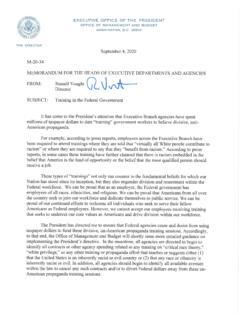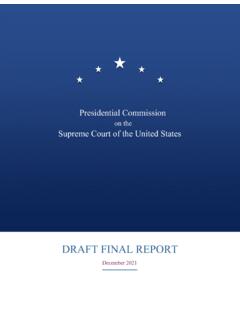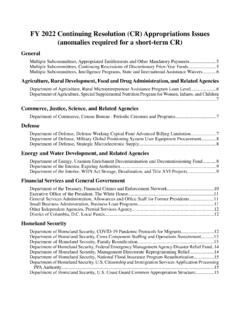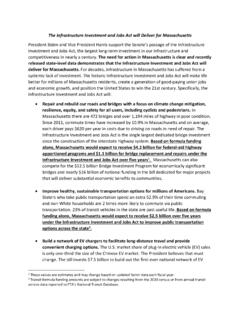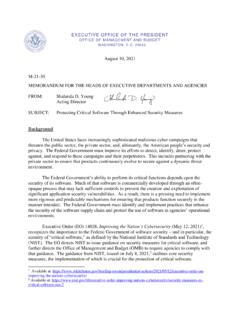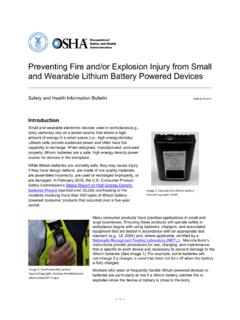Transcription of EXECUTIVEOFFICE OF THE PRESIDENT
1 EXECUTIVE OFFICE OF THE PRESIDENT O F F I C E O F M A N A G E M E N T A N D B U D G E T W A S H I N G T O N , D . C . 2 0 5 0 3 August 27, 2021 M-21-31 MEMORANDUM FOR THE HEADS OF EXECUTIVE DEPARTMENTS AND AGENCIES FROM: Shalanda D. Young Acting Director SUBJECT: Improving the Federal Government s Investigative and Remediation Capabilities Related to Cybersecurity Incidents Recent events, including the SolarWinds incident , underscore the importance of increased government visibility before, during , and after a cybersecurity incident . Information from logs on Federal information systems1 (for both on-premises systems and connections hosted by third parties, such as cloud services providers (CSPs)) is invaluable in the detection, investigation, and remediation of cyber threats.
2 Executive Order 14028, Improving the Nation's Cybersecurity,2 directs decisive action to improve the Federal Government s investigative and remediation capabilities. This memorandum was developed in accordance with and addresses the requirements in section 8 of the Executive Order for logging, log retention, and log management, with a focus on ensuring centralized access and visibility for the highest-level enterprise security operations center (SOC) of each agency. In addition, this memorandum establishes requirements for agencies3 to increase the sharing of such information, as needed and appropriate, to accelerate incident response efforts and to enable more effective defense of Federal information and executive branch departments and agencies. Section I: Maturity Model for Event Log Management This memo establishes a maturity model to guide the implementation of requirements across four Event Logging (EL) tiers, as described in Table 1 below.
3 1 As used in this memorandum, Federal information system has the meaning given in Executive Order 14028. 2 Available at 3 As used in this memorandum, agency has the meaning given in 44 3502. The requirements established by this memorandum do not apply to national security systems, as defined in Executive Order 14028. Table 1: Summary of Event Logging Tiers Event Logging Tiers Rating Description EL0 Not Effective Logging requirements of highest criticality are either not met or are only partially met EL1 Basic Only logging requirements of highest criticality are met EL2 Intermediate Logging requirements of highest and intermediate criticality are met EL3 Advanced Logging requirements at all criticality levels are met These tiers will help agencies prioritize their efforts and resources so that, over time, they will achieve full compliance with requirements for implementation, log categories, and centralized access.
4 Agencies should also prioritize their compliance activities by focusing first on high-impact systems and high value assets (HVAs). Tier EL0, Rating Not Effective The agency or one or more of its components have not implemented the following requirement: Ensuring that the Required Logs categorized as Criticality Level 0 are retained in acceptable formats for specified timeframes, per technical details described in Appendix C(Logging Requirements Technical Details). Tier EL1, Rating Basic The agency and all of its components meet the following requirements, as detailed in Table 2 (EL1 Basic Requirements) within Appendix A (Implementation and Centralized Access Requirements): Basic Logging Categories Minimum Logging Data Time Standard Event Forwarding Protecting and Validating Log Information Passive DNS Cybersecurity Infrastructure Security Agency (CISA) and Federal Bureau of Investigations (FBI) Access Requirements Logging Orchestration, Automation, and Response Planning User Behavior Monitoring Planning Basic Centralized Access 2 Tier EL2, Rating Intermediate The agency and all of its components meet the following requirements, as detailed in Table 3 (EL2 Intermediate Requirements) within Appendix A (Implementation and Centralized Access Requirements).
5 Meeting EL1 maturity level Intermediate Logging Categories Publication of Standardized Log Structure Inspection of Encrypted Data Intermediate Centralized Access Tier EL3, Rating Advanced The agency and all its components meet the following requirements, as detailed in in Table 4 (EL3 Advanced Requirements) within Appendix A (Implementation and Centralized Access Requirements): Meeting EL2 maturity level Advanced Logging Categories Logging Orchestration, Automation, and Response Finalizing Implementation User Behavior Monitoring Finalizing Implementation Application Container Security, Operations, and Management Advanced Centralized Access Section II: Agency Implementation Requirements Agencies must immediately begin efforts to increase performance in accordance with the requirements of this memorandum.
6 Specifically, agencies must: Within 60 calendar days of the date of this memorandum, assess their maturity against the maturity model in this memorandum and identify resourcing and implementation gaps associated with completing each of the requirements listed below. Agencies will provide their plans and estimates to their OMB Resource Management Office (RMO) and Office of the Federal Chief Information Officer (OFCIO) desk officer. Within one year of the date of this memorandum, reach EL1 maturity. Within 18 months of the date of this memorandum, achieve EL2 maturity. Within two years of the date of this memorandum, achieve EL3 maturity. Provide, upon request and to the extent consistent with applicable law, relevant logs to the Cybersecurity and Infrastructure Security Agency (CISA) and Federal Bureau of Investigation (FBI).
7 This sharing of information is critical to defend Federal information systems. Share log information, as needed and appropriate, with other Federal agencies to address cybersecurity risks or incidents. 3 Section III: Government-Wide Responsibilities The following agencies bear specialized responsibilities as part of government-wide efforts to improve the management and use of logging practices: CISA is responsible for the following actions: Deploying teams to advise agencies in their assessment of logging capabilities. Developing and publishing tools, in coordination with the FBI, to help agencies facilitate their assessment of logging maturity across the organization. The Department of Commerce is responsible for the following actions: Continuing to maintain National Institute of Standards and Technology (NIST) Special Publication (SP) 800-92,4 Guide to Computer Security Log Management, in coordination with CISA and the FBI.
8 Incorporating the requirements of this memorandum regarding logging, log retention, and log management in the next revision of SP 800-92 and other relevant publications. Section IV: Policy Assistance Address all questions or inquiries regarding this memorandum to the OMB Office of the Federal Chief Information Officer (OFCIO) via email: Attachments Appendix A: Implementation and Centralized Access Requirements Appendix B: Definitions Appendix C: Logging Requirements Technical Details 4 Available at 4 Appendix A: Implementation and Centralized Access Requirements Table 2: EL1 Basic Requirements Basic Logging Categories Ensuring that Required Logs categorized as Criticality Level 0 are retained in acceptable formats for specified timeframes, per technical details described in Appendix C.
9 Minimum Logging Data At a minimum, agencies shall ensure that each event log contains the following data, if applicable: Properly formatted and accurate timestamp (see below for Time Standard Requirements) Status code for the event type Device identifier (MAC address5 or other unique identifier) Session / Transaction ID Autonomous System Number Source IP (IPv4) Source IP (IPv6) Destination IP (IPv4) Destination IP (IPv6) Status Code Response Time Additional headers ( , HTTP headers) Where appropriate, the username and/or userID shall be included Where appropriate, the command executed shall be included Where possible, all data shall be formatted as key-value-pairs allowing for easy extraction Where possible, a unique event identifier shall be included for event correlation; a unique event identifier shall be defined per event 6 type5 Agencies should configure all hosts to have MAC randomization turned off.
10 Where possible, this configuration should be maintained automatically. 6 Software developed by agencies or by contractors on behalf of agencies must log unique event identifiers for each event in accordance with these requirements. 5 Time Standard Consistent timestamp formats across all event logs are necessary for accurate and efficient event correlation and log analysis. Timestamps must be applied consistently to logs from all computing devices, routers, switches, and servers. Agencies shall maintain log timestamps in a format that meets the following requirements, based on both ISO 7 8601 and RFC 3339: Date and Time on the Internet: Timestamps. YYYY-MM-DDThh: (Zulu time, UTC+0) and YYYY-MM-DDThh: +04:00 (UTC+4) YYYY = four-digit year MM = two-digit month DD = two-digit day of the month T = a set character indicating the start of the time element hh = two digits of an hour (00 through 23) mm = two digits of a minute ss = two digits of a second mmm = three digits of a millisecond (000 through 999) +|-= time zone designator (Z or +hh:mm or -hh:mm), the + or values indicate how far ahead or behind a time zone is from the UTC (Coordinated Universal Time) zone.


